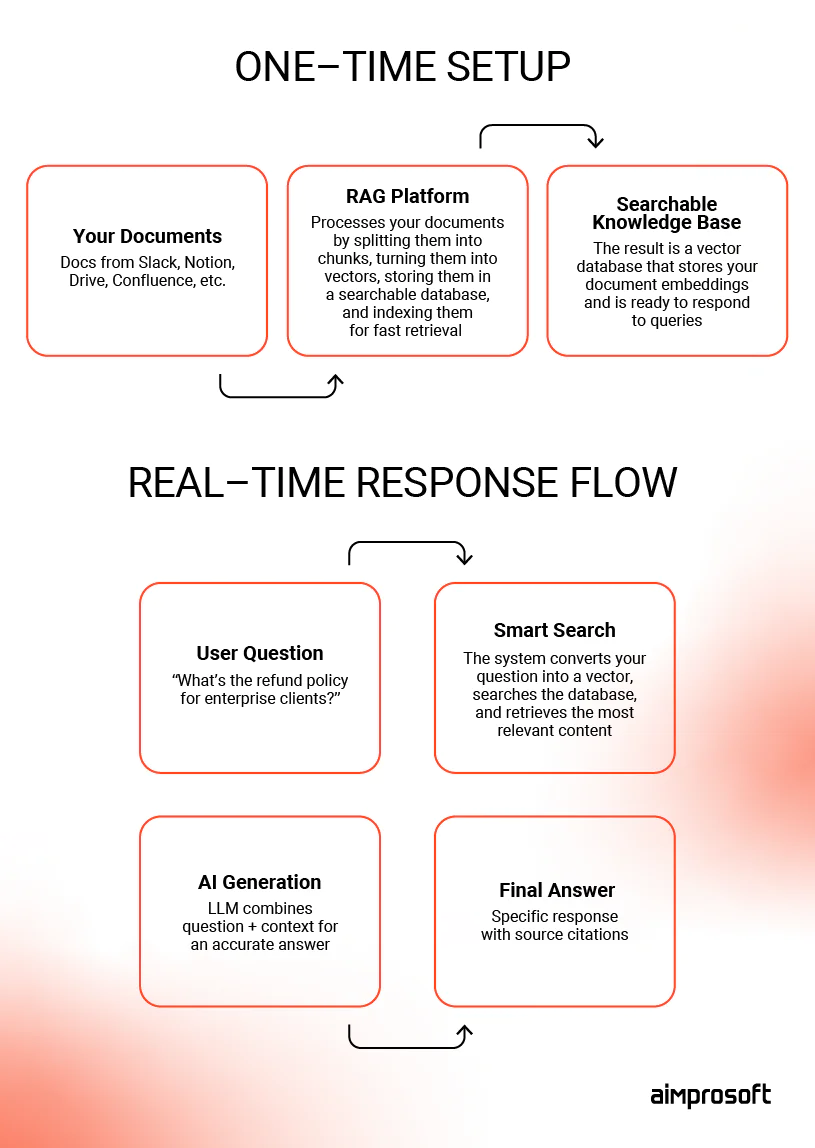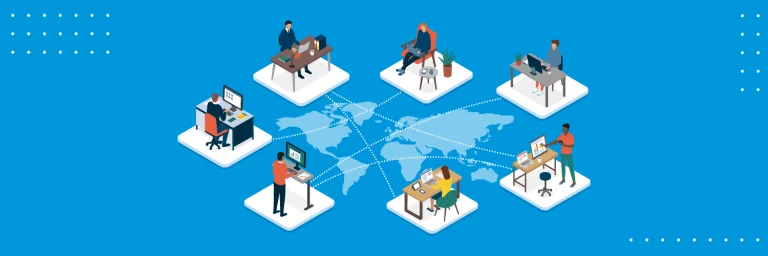5 RAG-as-a-Service Platforms Compared: Features, Pricing, and What Fits Your Team
If you’ve ever watched your team waste hours searching for that one crucial document, you’re not alone. Slack threads, misnamed PDFs, outdated folders, or files locked away on someone’s vacationing laptop-modern businesses are overflowing with information. The irony is painful, as finding what you need remains one of the biggest productivity killers across organizations.
You might think AI tools would solve this problem. And they can, but traditional AI models often hallucinate, providing plausible but completely incorrect information. When your clients are counting on accurate answers, that’s not just embarrassing – it’s business-threatening.
Retrieval Augmented Generation (RAG) has become the silver bullet for this exact problem. Instead of letting AI models guess or pull from their training data, RAG connects them directly to your proprietary information. It’s like handing your AI a map to everything your company knows, so it retrieves facts, eliminating those costly hallucinations.
But here’s where most companies hit a wall: building custom RAG systems requires time, resources, and specialized skills that aren’t exactly lying around. That’s why RAG-as-a-service platforms have exploded in popularity. They promise all the benefits of custom RAG development, delivered in weeks instead of months.
Yet, the RAG-as-a-Service market is crowded, and choosing the wrong platform can set you back more than it helps. That’s why we’re breaking down everything you need to know about RAG-as-a-service platforms, including how they work for different business types, their costs, and how to avoid common pitfalls.
But before we dive into specific platforms, let’s clarify exactly what we’re talking about when we say RAG-as-a-Service.
What is RAG-as-a-Service?
RAG-as-a-Service (Retrieval Augmented Generation as a service) combines AI search with generative models to deliver direct, context-aware answers, not just links. Unlike traditional search engines, retrieval-augmented generation tools extract relevant data from your documents and feed it into an AI model that generates grounded, trustworthy responses. However, regardless of how sophisticated RAG systems become, having domain experts validate the quality and accuracy of responses remains essential for maintaining reliability and catching potential errors that automated systems might miss.
Instead of building and maintaining complex infrastructure, businesses can now rely on RAG as a service providers to handle heavy lifting. These platforms offer ready-to-use solutions that turn document sprawl into a smart, searchable knowledge system in weeks, saving both your time and money.

So why not just pick one and get started? Fair question. But here’s the thing: Not all RAG-as-a-Service platforms work the same way. Some platforms are better at handling messy documents, while others shine when speed or accuracy is critical. A few require technical teams to set things up, while others are designed to work out of the box. Knowing these nuances upfront can help you avoid wasted time, budget, and frustration.
To make your choice easier, we’ve reviewed five of the RAG platforms our engineers have leveraged for projects. In this RAG platforms comparison, you’ll learn how each retrieval augmented generation platform works, what kind of teams they’re best suited for, and how they can support your business goals.

1. Vectara
In finance, legal, or healthcare, “mostly accurate” isn’t good enough – you need bulletproof reliability or you risk regulatory violations, lawsuits, or worse. Vectara RAG is the enterprise-grade fortress of RAG platforms, built from the ground up to prevent hallucinations, support high–performance scaling, and integrate with a wide range of LLMs, data sources, and file types.
Whether you’re powering RAG for enterprise search, building internal copilots, or delivering AI features inside customer-facing apps, Vectara gives your teams the tools to launch fast and stay accurate. Its fully managed architecture handles ingestion, search, and generation at scale.
Key features:
- Hallucination detection: Built-in safeguards that flag and block inaccurate responses before they reach end users.
- Multi-language support: The Vectara API supports 100+ languages without extra setup.
- Enterprise-grade security: SOC 2, HIPAA, and GDPR compliance built in.
- Hybrid search: Combines semantic understanding with keyword search for better precision.
- Auto-scaling: Automatically adjusts to traffic spikes without manual intervention.
Vectara works best for:
- Enterprises in regulated industries (finance, legal, healthcare) that require traceable, citation-backed AI responses.
- Product and platform teams building customer-facing features that demand multilingual, high-precision output.
- Global organizations with large, messy content repositories in multiple formats and languages.
- Companies that need enterprise-grade RAG without the cost and complexity of managing infrastructure in-house.
Our Vectara review takeaway:
This is the platform for when failure isn’t an option. You’ll pay premium pricing for enterprise-grade reliability, but if incorrect information could cost you clients compliance violations, or reputation damage, that’s a bargain. If you’re running a lean operation, it might make sense to explore more affordable alternatives, unless reliability is your top priority.
Starting free with their Standard plan, you can test the waters before moving to Pro or Enterprise levels –making it easier to explore what a RAG pipeline with Vectara AI looks like before committing to long-term usage. While smaller teams might find it more than they need, the pricing structure makes it accessible for testing enterprise-grade reliability.

2. Nuclia
Nuclia RAG works best for mid-to-large tech teams who’ve outgrown basic search. With Nuclia AI search, teams can apply domain-specific strategies to gain more relevant, contextual results from messy or technical documentation. Unlike fixed-pipeline tools, Nuclia provides full control over ingestion, chunking, embedding, and indexing, allowing you to apply domain–specific strategies. It supports cloud, hybrid, or on-premises deployment options, so you can choose what’s best for your security and compliance needs.
With well-documented REST APIs, Python/TypeScript SDKs, CLI tools, and the open-source NucliaDB, it integrates cleanly into development environments. If your team wants flexibility without reinventing the wheel, Nuclia is a solid fit.
Key features:
- Custom pipeline control: Fine-tune chunking, embedding, and indexing logic.
- Multimodal ingestion: Works with PDFs, video, audio, JSON, and more.
- Multi-language search: Designed for global tech teams with varied content.
- Nuclia API + SDKs: A flexible, unstructured data search API that integrates easily with your stack.
- Enterprise–ready security: SOC 2 and ISO 27001 compliance.
Nuclia works best for:
- Mid-sized to large product teams (50-500 employees).
- Engineering teams spend hours daily searching through docs and internal wikis.
- Organizations with mixed-format and multi-language documentation.
- Businesses that want deep customization and hybrid deployment options.
Our Nuclia AI review takeaway:
Nuclia excels when you have technical staff ready to configure it. With plans starting at $600 monthly and scaling to $1,500-$3,333+ for the Growth tier (with Enterprise custom pricing from $12.5k+ annually), it’s positioned for serious technical implementations. The trial option helps you test the fit, but you’ll need 4-6 weeks and someone who understands both your content structure and how to tune embeddings.

3. Ragie AI
If you’re racing against time, Ragie AI is the kind of retrieval-augmented generation tools that helps product teams deliver AI-powered features fast. Ragie RAG as a service helps product teams launch AI-powered features like support search, document Q&A, or internal copilots in weeks, not months.
The Ragie platform is fully managed and API-first, making it easier to integrate multimodal data, such as video, PDFs, and chat logs, without building infrastructure from scratch. Whether you’re building AI copilots into your app or powering internal tools across departments, Ragie gives you production-grade RAG features without heavy lifting.
Key features:
- Quick launch: Go from sign-up to live product in 2-3 weeks.
- Multimodal search: Seamlessly handles PDFs, videos, Slack messages, and more.
- Native integrations: Syncs with tools like Notion, Google Drive, and Confluence.
- LLM-based reranking: Prioritizes relevant answers over noise.
- SOC 2-ready: Built with security in mind, even for lean teams.
Ragie AI works best for:
- Small to mid-sized product teams (10-50 people) under deadline pressure.
- Startups needing MVP-ready AI features.
- Product teams with AI goals but no time to build infrastructure from scratch.
- Companies with diverse content types in their support libraries.
Our Ragie review takeaway:
Perfect for “we need this working by demo day” scenarios. You can opt for Ragie’s free tier for testing, then $100 monthly for 10k pages, up to $500 for 60k pages, with Enterprise options available. You’ll trade some flexibility for speed, but the predictable pricing makes it budget–friendly for rapid prototyping and mid-scale deployments.

4. Ragu AI
Unlike platforms focused solely on speed, Ragu AI emphasizes long-term reliability through control, compliance, and hands-on support. It’s a semi-managed solution. Meaning you don’t just get a platform; you get AI engineers who help tailor the RAG to your unstructured data structure, business logic, and governance needs.
With Ragu, teams can build domain-specific, document-based AI assistants that reflect how they actually work. You can fine-tune how documents are segmented, which data sources are prioritized, and how answers are scored. Whether you’re operating in a highly regulated industry or simply need deep customization, the Ragu platform gives you the architectural control and expert guidance to build it right from the start.
Key features:
- Customizable pipeline: Configure every step from chunking to scoring.
- Agent support: Build doc-based AI agents tailored to your workflows.
- Consultative onboarding: Includes hands-on guidance and architectural input.
- Compliance-ready: Can be tuned to meet industry-specific governance needs.
- Built to scale: Designed to evolve alongside growing orgs and complexity.
Ragu AI works best for:
- Companies (100-1000 employees) in legal, healthcare, or finance.
- Teams that are facing regulatory constraints on internal search and AI usage.
- Businesses that need flexibility but lack deep in-house AI expertise.
- Organizations view RAG as a long-term investment, rather than a one-time hackathon.
Our Ragu AI review takeaway:
Ragu works best for companies treating knowledge management as a strategic investment, not a quick fix. With custom, usage-based pricing quotes, you’ll pay more but get a solution that grows with you. However, if your team needs a lightweight, DIY solution or fast delivery, Ragu AI alternatives like Ragie or pre-built apps might be a better short-term fit.

5. Personal AI
Unlike other RAG-as-a-Service platforms built for teams or enterprise workflows, Personal AI focuses entirely on the individual user. This platform builds a persistent, timeline-based memory stack from your data, like emails, notes, and meetings. Instead of relying on team-wide databases or enterprise systems, it learns from your own input. That makes it more of an AI memory assistant than a document retriever.
Unlike platforms built for support teams or compliance-heavy industries, Personal AI acts as a self-contained personal AI agent. It helps you prep, write, and recall faster without external integrations or complex setups.
Key features:
- Memory stack: Turns scattered data into a timeline-based graph.
- MODEL-1: Personal reflection model that mirrors your voice, style, and opinions.
- Privacy-first: Full ownership, no training on your data.
- Multi-persona support: Train multiple assistant personalities for different roles.
- Lightweight integration: Browser extension and web app available.
Personal AI works best for:
- Content creators and writers who need to maintain a consistent voice across projects.
- Executives who manage multiple contexts (board meetings, team interactions, client relationships).
- Researchers and analysts who need to connect insights across time periods.
- Consultants who work with multiple clients and need context switching.
Our Personal AI review takeaway:
This is for individuals, not teams. From our experience, you’ll likely save 5-8 hours a week on prep, recall, and writing. Personal AI offers a free tier and personal plans ($15-$40 monthly, plus Enterprise custom pricing). It’s accessible for knowledge workers who want their personal LLM assistant. But if you need a collaborative, organization-wide solution, the platform won’t fit the bill.
5 common missteps to avoid when choosing a RAG-as-a-Service platform
As more companies turn to RAG-as-a-Service to power enterprise search, internal copilots, or customer-facing assistants, the gap between expectations and results often reveals itself quickly. Whether you’re working with a leading RAG as a service provider, exploring an AI personal assistant for business, or trying to build a RAG pipeline in-house, success depends on more than just picking up a tool.
Retrieval-augmented generation as a service promises faster insights and smarter AI, but even the best RAG platforms can fall short if you skip critical planning steps.
1. Underestimating setup complexity
Even “plug-and-play” platforms typically need 2-4 weeks of content prep, testing, and integration. RAG isn’t magic, it still requires upfront work.
2. Ignoring content quality
If your documents are messy, outdated, or inconsistent, your AI answers will be too. RAG systems retrieve what’s already there – they don’t rewrite it for clarity.
3. Skipping security requirements early
It’s painful to discover compliance gaps after you’ve integrated. Make sure the platform meets your industry’s security and data governance standards from the start.
4. Choosing based on polished demos
Demos often use ideal content. Always test the platform using your actual documents and real-world use cases before committing.
5. Overlooking long-term costs
Usage-based pricing might look affordable upfront, but it can grow quickly as adoption scales. Model out your expected growth scenarios before signing on.
Choosing a RAG platform isn’t just a tech decision – it’s a business one. What works brilliantly for a 10-person startup might create bottlenecks in a regulated enterprise. Every tool listed here has real strengths – but also real trade-offs. Before selecting a retrieval augmented generation platform, think about your team’s skillset, content quality, and long-term goals.
And if you’re still unsure? Start small. Most RAG-as-a-Service platforms offer free trials or affordable entry plans that let you learn as you go. If you need a second opinion or want to talk through your use case, we’re happy to share what’s worked (and what hasn’t) across the retrieval augmented generation services we’ve delivered.
We know you might not have time to re-read the whole article, so we’ve compiled a quick guide to the RAGaaS platforms we covered.




